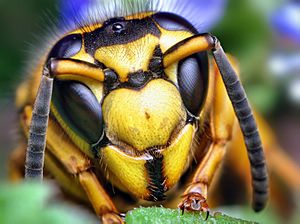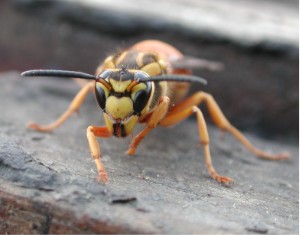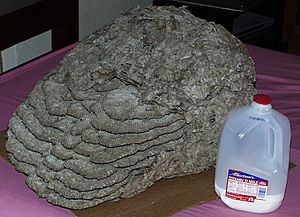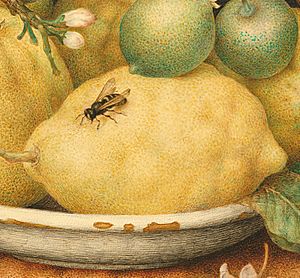Yellowjacket facts for kids
Quick facts for kids Yellowjacket |
|
|---|---|
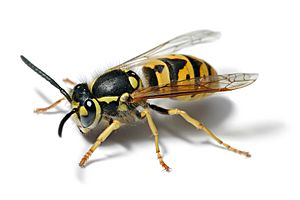 |
|
| Scientific classification | |
| Kingdom: | |
| Phylum: | |
| Class: | |
| Order: | |
| Family: | |
| Subfamily: |
Vespinae
|
| Genus: |
Vespula or Dolichovespula
|
Yellowjackets are a type of social wasp found in North America. People in other English-speaking countries simply call them "wasps." Most yellowjackets are black and yellow, like the eastern yellowjacket. Some are black and white, such as the bald-faced hornet. You can spot them by their unique markings, the way they live in large groups called colonies, and their quick, side-to-side flight before landing. All female yellowjackets can sting. These wasps are helpful because they hunt and eat many insects that can be pests.
Contents
What are Yellowjackets?
How to Identify a Yellowjacket
Yellowjackets can sometimes be mistaken for other wasps or even bees. A typical worker yellowjacket is about 12 millimeters (0.5 inches) long. They have stripes on their bodies. The queen yellowjacket is larger, around 19 millimeters (0.75 inches) long. The different patterns on their bodies help scientists tell different species apart.
Even though they look a bit like honey bees, yellowjackets are wasps. Honey bees are usually covered in fuzzy, tan-brown hair. Yellowjackets, however, have smooth bodies with bright yellow or white markings. Honey bees also have special flat, hairy legs for carrying pollen, which yellowjackets do not.
Yellowjacket Stingers and Nests
Yellowjackets have stingers that are like tiny spears with small barbs. They can sting many times. Their venom is usually only dangerous to people who are allergic or get stung a lot. All yellowjackets have yellow or white markings on their faces.
Their mouths are strong and well-developed. They have powerful mandibles (jaws) for catching and chewing insects. They also have a proboscis (a tube-like mouthpart) for sipping nectar, fruit juices, and other liquids.
Yellowjackets build their nests from wood fibers that they chew into a paper-like material. They often build nests in trees, shrubs, or hidden spots. These spots can include inside buildings, in holes in the ground, inside tree stumps, or even in old mouse burrows. Many other insects, like some flies, moths, and beetles, copy the look of yellowjackets to scare away predators. This is called mimicry.
Yellowjackets are closely related to hornets. Hornets look similar but have bigger heads. You can see this especially in the space between their eyes and the back of their heads.
The Yellowjacket Life Cycle
How Colonies Start and Grow
Yellowjackets are social insects, meaning they live in organized groups called colonies. A colony includes workers, queens, and males (drones). Most yellowjacket colonies only last for one year. Only the queens that have mated survive the winter. These fertilized queens hide in safe places like hollow logs, under tree bark, in leaf piles, or in human-made structures.
Queens come out when the weather gets warm in late spring or early summer. They choose a place for their nest and build a small paper nest. Inside, they lay eggs. After the eggs hatch, the queen feeds the young larvae (baby wasps) for about 18 to 20 days. The larvae then turn into pupae, and later emerge as small, infertile female workers.
By midsummer, the first adult workers appear. They take over the jobs of making the nest bigger, finding food, taking care of the queen and larvae, and defending the colony. From this time until she dies in the autumn, the queen stays inside the nest and keeps laying eggs.
Colony Size and Reproduction
The colony grows quickly, reaching its largest size in late summer. A typical colony can have 4,000 to 5,000 workers and a nest with 10,000 to 15,000 cells. Some species, like Vespula squamosa in warmer areas, can build much larger colonies that last for more than one year. These huge colonies can have dozens of queens, tens of thousands of workers, and hundreds of thousands of cells.
When the colony is at its peak size, new male and queen yellowjackets are produced. These new adults stay in the nest and are fed by the workers. The new queens eat a lot to build up fat reserves, which helps them survive the winter. After mating, the males die quickly. The fertilized queens then find safe places to spend the winter. The workers in the parent colony slowly die off, and the original queen also dies. The old nests usually fall apart during the winter.
What Yellowjackets Eat
Adult yellowjackets mostly eat sugary foods like fruits, flower nectar, and tree sap. The larvae, however, need protein. They eat insects, meat, and fish that the worker yellowjackets bring back. Workers chew up these foods before feeding them to the larvae. Many of the insects that yellowjackets hunt are considered pests, which means yellowjackets can be helpful for agriculture. In return, the larvae give the workers a sugary substance to eat. This sharing of food is called trophallaxis. As summer ends and insect food becomes harder to find, the larvae produce less sugar for the workers. This causes the workers to look for other sources of sugar outside the nest, like ripe fruits and human garbage.
Types of Yellowjackets
There are many different kinds of yellowjackets around the world:
- The German wasp (Vespula germanica) and the common wasp (Vespula vulgaris) are from Europe. They are now found in places like southern Africa, New Zealand, and eastern Australia.
- The North American yellowjacket (Vespula alascensis), eastern yellowjacket (Vespula maculifrons), western yellowjacket (Vespula pensylvanica), and prairie yellowjacket (Vespula atropilosa) are native to North America.
- The Southern yellowjacket (Vespula squamosa) is found in the southern United States.
- Bald-faced hornets (Dolichovespula maculata) are actually a type of yellowjacket, even though they are called "hornets." They are black and white, not yellow, so they are not usually called "yellowjackets."
- The Aerial yellowjacket (Dolichovespula arenaria) builds its nests in the air.
- The Tree wasp (Dolichovespula sylvestris) is another type of yellowjacket.
Yellowjacket Nests
Where Yellowjackets Build Their Homes
Some yellowjacket species, like the aerial yellowjacket (D. arenaria) and the bald-faced hornet, build their nests out in the open, often hanging from trees or shrubs. This is similar to how some true hornets build their nests, which can sometimes cause confusion.
Other yellowjacket species, like those in the Vespula group, build their nests in hidden places. These are usually underground.
Most yellowjacket nests only last for one season, with the wasps dying off in winter. A single queen starts the nest. By the end of the season, a nest can grow to be as big as a basketball. However, in places with mild winters, like parts of Australia, New Zealand, the Pacific Islands, and the southwestern United States, nests can survive for more than one season. These multi-season nests become very large and often have many queens laying eggs.
Yellowjackets in the United States
The German yellowjacket (V. germanica) first appeared in Ohio in 1975 and has become very common. It is known for being bold and aggressive, and it can sting many times. It will even remember and chase people who bother it. This wasp is sometimes confused with another invasive species, Polistes dominula, because they look very similar. German yellowjackets build their nests in cavities, not always underground. Their colonies can have between 1,000 and 3,000 workers from May to August. Each colony produces thousands of new queens and males later in the year.
The eastern yellowjacket builds its nests underground. Its colonies also have between 1,000 and 3,000 workers, similar to the German yellowjacket. Their nests are made entirely of chewed wood fiber and are completely enclosed, with only a small entrance at the bottom. The color of the nest paper depends on the type of wood used. Inside, the nests have many horizontal layers of combs where the larvae hang.
In the southeastern United States, where winters are mild, southern yellowjacket (V. squamosa) nests can last through the winter. These colonies can grow to have as many as 100,000 adult wasps! The same kind of huge nest growth has happened in Hawaii with the invasive western yellowjacket (V. pensylvanica).
Yellowjackets in Pop Culture
Yellowjackets are quite famous in American popular culture, especially as mascots for sports teams. The most well-known example is the Georgia Tech Yellow Jackets, whose mascot is named Buzz. Many other colleges and universities also use the yellowjacket as their mascot, including Allen University, American International College, Baldwin-Wallace University, and the University of Rochester.
Even the mascot for the Columbus Blue Jackets hockey team, named "Stinger," looks a lot like a yellowjacket. While it was originally yellow, its color was changed to light green, mixing the real insect's yellow with the team's blue.
It's interesting to note that "yellowjacket" is often spelled as two words ("yellow jacket") in everyday use. However, the correct scientific spelling, according to experts, is one word: "yellowjacket."



